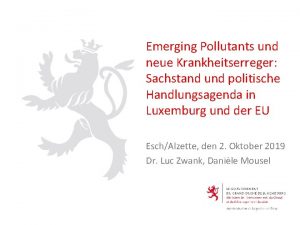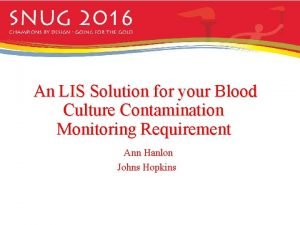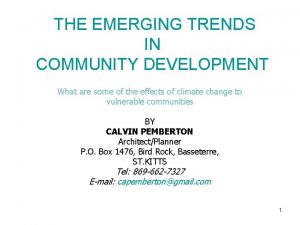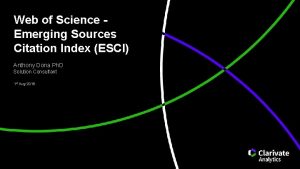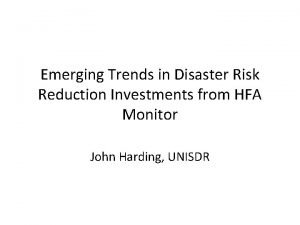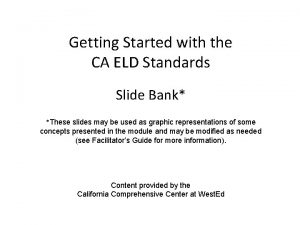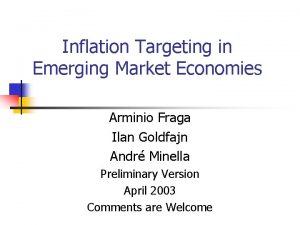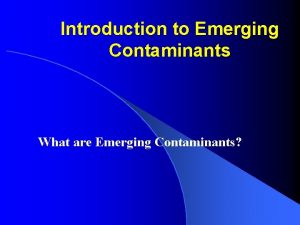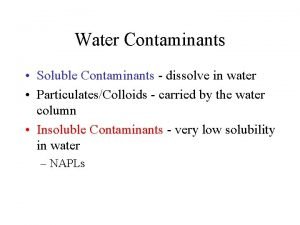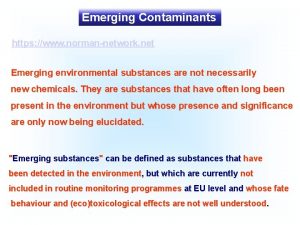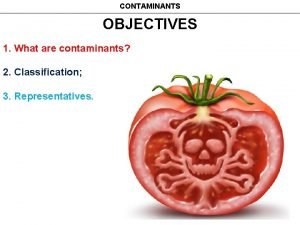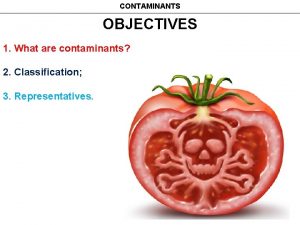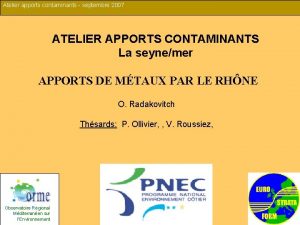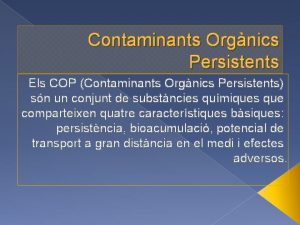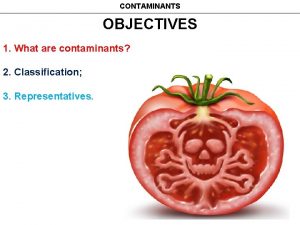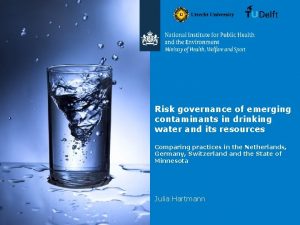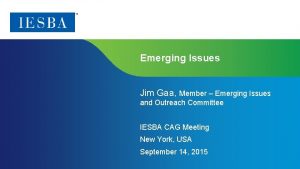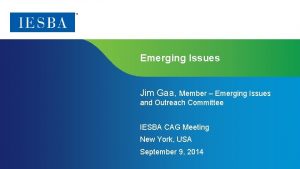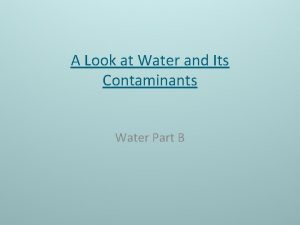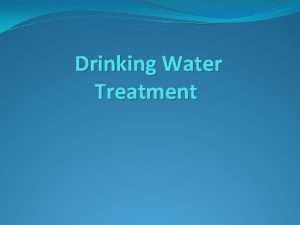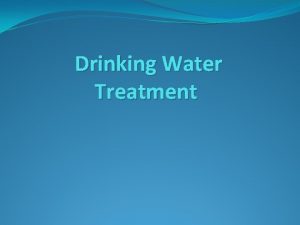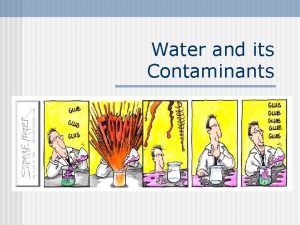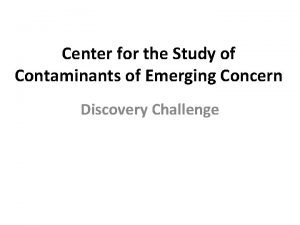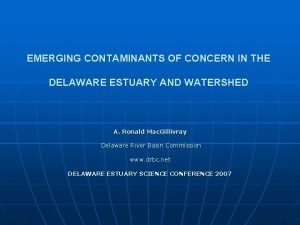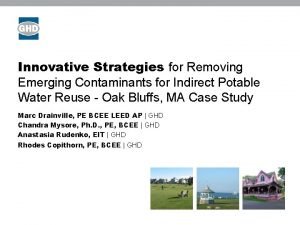Issues with Emerging Contaminants in Water What are

































































- Slides: 65

Issues with Emerging Contaminants in Water

What are “emerging contaminants”? • PPCPs and EDCs – Pharmaceuticals – Personal Care Products – Endocrine Disrupting Compounds • Emerging emerging contaminants?

Pharmaceuticals • Human and veterinary substances taken in response to disease/maladies. – Cure disease – Alleviate disease associated symptoms – Prevent disease • “The human impulse for a cure runs quite deep, and our first instinct whenever we feel sick or heading toward sickness is to medicate. ” – Jjemba, 2008

Personal Care Products • Compounds used in our daily lives – Soaps, detergents, perfumes, aftershaves – Cleaning agents, disinfectants, sprays, deodorants – Bug sprays, sunscreens – Products are typically associated with hygiene

Endocrine Disrupting Compounds • Disrupt normal function of the endocrine system • Mimic hormones; agonize or antagonize hormone activity, synthesis, or metabolism; modify hormone receptors • Active at very low levels • Concern about additive or synergistic effects caused by mixtures of EDCs • Synthetic Estrogens – Ethinyl Estradiol, bisphenol-A • Synthetic Androgens – 90% of US cattle receive growth hormone implants – Synthetic androgens remain environmentally active for months

Emerging, emerging contaminants • What’s next? – Technology will always get better • New products • New ways to find chemicals at lower concentrations – NDMA found in beer by accident – EDC activity of bisphenol-A (BPA) found by accident – Green revolution dumped millions of tons of pesticides and herbicides into the environment, but also created enough food for billions of people!!!

A Brief History of “Emerging” Contaminants



Developments in Industrial Microbiology - 1970




EDC Stories Lake Mead Feminized Carp • Found vitellogenin in male carp of Las Vegas wash and Bay in Lake Mead – Egg producing protein – Elevated levels in female fish • Found elevated levels of several potential EDCs – Ethinyl Estradiol – Las Vegas wastewater treatment plant outfall "Synthetic Organic Compounds and Carp Endocrinology and Histology, Las Vegas Wash and Las Vegas and Callville Bays of Lake Mead, Nevada, 1992 and 1995, " by Hugh E. Bevans, et. al





EDC Stories Lake Apopka Alligators • A “Teeny Weenie” Problem – Kyla Dunne for PBS (June 2, 1998) • http: //www. pbs. org/wgbh/pages/frontline/shows/nature/gallery/alligators. html • Lou Guillette from the University of Florida – 25% smaller phallus in the adult and juvenile male alligators of lake Apopka – Low testosterone levels compared to levels in alligators from healthy lake – Penis size did not reflect amount of testosterone in blood "Developmental Abnormalities of the – Causes? Gonad and Abnormal Sex Hormone • 1980 DDT and dicofol spill into the lake • Chemical runoff from agriculture • Discharge from Sewage Treatment plant – Proving the link • Took alligator eggs from “Clean” lake • Grew them in p, p’ DDE and found similar results to Lake Apopka alligators Concentrations in Juvenile Alligators from Contaminated and Control Lakes in Florida". Environmental Health Perspectives 102(8): 680 -688 "Reduction in Penis Size and Plasma Testosterone Concentrations in Juvenile Alligators Living in a Contaminated Environment". General and Comparative Endocrinology 101: 32 -42.

Where have EDCs/PPCPs been found? • Surface waters throughout the world – Europe, Asia, Canada, USA • USGS report “Pharmaceuticals, hormones, and other organic wastewater contaminants in US streams 1999 -2000: A national reconnaissance” – 95 compounds – 139 streams throughout US sampled • 80% tested positive – ES&T 36 (6), 1202 Koplin et al. , 2002

EDC Stories (Hermaphroditic Frogs) • Tyrone Hayes – “Feminization of male frogs in the wild” (Nature, 419: 895 -896) • Investigated the effects of exposure to waterborne atrazine contaminiation on Leopard Frogs • Examined different regions of US (Iowa – Utah) • Found 10 -92% of males showed gonadal abnormalities – “Atrazine-induced hermaphroditism at 0. 1 ppb in American Leopard Frogs (Rana pipiens): Laboratory and field evidence” (EHP, 111: 568 -575)

Government Regulations • Compounds are not currently regulated in the United States as EDCs – Process started in 1996 – Endocrine Disrupting Screening Program (EDSP) • Assay development and validation team – Scientific and Technical validation of EDC screens • Priority setting workgroup – Develop and prioritize which compounds are tested as EDCs • Regulatory activities workgroup – Working on regulatory procedures needed to implement EDSP http: //www. epa. gov/scipoly/oscpendo/


Samples collected per time zone 195 43 88 17 Participating Utilities

Target Compounds Pharmaceuticals (20) Atenolol Atorvastatin o-Hydroxy atorvastatin p-Hydroxy atorvastatin Carbamazepine Diazepam Diclofenac Dilantin Enalapril Fluoxetine Norfluoxetine Gemfibrozil Meprobamate Naproxen Risperidone Simvastatin hydroxy acid Sulfamethoxazole Triclosan Trimethoprim Potential EDCs (26) Atrazine Benzophenone BHA BHT a-BHC b-BHC g-BHC Bisphenol A Butylbenzyl phthalate DEET Diazinon Dioctyl phthalate Galaxolide Linuron Methoxychlor Metolachlor Musk ketone Nonylphenol Octachlorostyrene Octylphenol TCEP TCPP Tonalide Traseolide Vinclozolin Steroid Hormones (5) Phytoestrogens (11) Estradiol Estrone Ethinylestradiol Progesterone Testosterone Apigenin Biochanin A Chrysin Coumestrol Daidzein Equol Formononetin Genistein Glycitein Matairesinol Naringenin

Detected in Raw Water* (24/62) Pharmaceuticals Atenolol Atorvastatin o-Hydroxy atorvastatin p-Hydroxy atorvastatin Carbamazepine Diazepam Diclofenac Dilantin Enalapril Fluoxetine Norfluoxetine Gemfibrozil Meprobamate Naproxen Risperidone Simvastatin hydroxy acid Sulfamethoxazole Triclosan Trimethoprim Potential EDCs Atrazine Benzophenone BHA BHT a-BHC b-BHC g-BHC Bisphenol A Butylbenzyl phthalate DEET Diazinon Dioctyl phthalate Galaxolide Linuron Methoxychlor Metolachlor Musk ketone Nonylphenol Octachlorostyrene Octylphenol TCEP TCPP Tonalide Traseolide Vinclozolin Steroid Hormones Phytoestrogens Estradiol Estrone Ethinylestradiol Progesterone Testosterone Apigenin Biochanin A Chrysin Coumestrol Daidzein Equol Formononetin Genistein Glycitein Matairesinol Naringenin * In at least 20% of samples

Detected in Drinking Water* (11/62) Pharmaceuticals Atenolol Atorvastatin o-Hydroxy atorvastatin p-Hydroxy atorvastatin Carbamazepine Diazepam Diclofenac Dilantin Enalapril Fluoxetine Norfluoxetine Gemfibrozil Meprobamate Naproxen Risperidone Simvastatin hydroxy acid Sulfamethoxazole Triclosan Trimethoprim Potential EDCs Atrazine Benzophenone BHA BHT a-BHC b-BHC g-BHC Bisphenol A Butylbenzyl phthalate DEET Diazinon Dioctyl phthalate Galaxolide Linuron Methoxychlor Metolachlor Musk ketone Nonylphenol Octachlorostyrene Octylphenol TCEP TCPP Tonalide Traseolide Vinclozolin Steroid Hormones Estradiol Estrone Ethinylestradiol Progesterone Testosterone Phytoestrogens Apigenin Biochanin A Chrysin Coumestrol Daidzein Equol Formononetin Genistein Glycitein Matairesinol Naringenin * In at least 20% of samples

US Drinking Water Finished Water for 18 Drinking Water Treatment Facilities Compound Max (ng/L) Median (ng/L) Frequency (%) Atrazine 870 49 83 Meprobamate 42 5. 7 78 Dilantin 19 6. 2 56 Atenolol 18 1. 2 44 Carbamazepine 18 6. 0 44 Gemfibrozil 2. 1 0. 48 39 TCEP 470 120 39 DEET 93 63 33 Metolachlor 27 16 33 TCPP (Fyrol PCF) 510 28 Sulfamethoxazole 3. 0 0. 39 22

AP Story (March, 2008)

Relevance to Human Health

How much would you have to consume? ? Compound Daily Dose (mg) Phenytoin (Dilantin) Phenobarbital (Luminal) Carbamazepine (Tegretol) Primidone ( Myidone) Hydrocodone Codeine Diazepam (Valium) Guaifenesin (Robitussin) Pentoxifylline (Trental) 300 - 400 30 - 300 800 - 1200 750 - 1000 20 - 38 120 - 180 12 - 1200 - 2400 800 - 1200 NOTE: EPA Reference Intake = 2 L/day Liters 1, 200, 000 770, 000 23, 000 5, 800, 000 1, 500, 000 980, 000 190, 000 23, 000 16, 000

Human Impacts? • Nelson and Bunge, 1974: – Missouri men have lower sperm counts than men in LA, NY, and Minneapolis – No reason found • Swan et al. , 2003: – Confirmed earlier study – Missouri low-sperm count men had higher levels of Atrazine, Alachlor, and Diazanon – Link between pesticides and reproductive effect – No occupational exposure – Source Identified: Drinking water contamination

More Human Cases • DES Daughters • Hypospadias doubled from 1970 -1991 (Paulozzi et al, 1997) • Dioxins and endometriosis in monkeys (Rier and Foster, 2002) • Link between increases in breast, testicular and prostate cancers over past 40 years? ? ? (Krishnan and Safe, 1993; Carlsen et al. , 1995; EPA, 1997; more) • All linked to hormone mimicking or disrupting compounds

Awwa. RF/Wate. Reuse Foundation Tailored Collaboration: “Toxicological Relevance of EDCs and Pharmaceuticals in Water” Projects 3085/04 -003 - Dr. Djanette Khiari – Awwa. RF - Mr. Joshua Dickinson - WRF

E-screen Assay • MCF-7 breast cancer cells proliferate in response to estrogenic compounds • Developed by oncologists Ana Soto & Carlos Sonnenschein at Tufts University

E-screen Results (EEq ng/L) 1700 4000 300 nd 0. 6 0. 7 0. 8 2. 5 2. 9 4. 6 6. 0 13

EEq Comparison (“Worst” WWTP) 1 cup coffee (17 ng/L, 240 m. L) 890 m. L Secondary Wastewater (4. 6 ng/L)

EEq Comparison Teaspoon of Soy Sauce (300 ng/L, 15 m. L) 1 Liter Secondary Wastewater (4. 6 ng/L)

EEq Comparison Soy Baby Formula (1700 ng/L, 4 oz Bottle) 44 Liters of Secondary Wastewater (4. 6 ng/L)

Daily Intake of EEq (ng) Comparison • “Typical” day for average adult, per serving Breakfast 2 Cups coffee = 8. 2 ng Glass of Juice = 0. 2 ng Lunch Glass of milk = 0. 1 ng Dinner Sushi w/ soy sauce = 4. 5 ng • Est. Total Daily intake of EEq Glass of beer = 2. 2 ng = 15. 9 ng Cup of tea = 0. 7 ng

What is the Context for Risk? • • Food Exposure Air Exposure Water Exposure Health Endpoints – Cancer – Non-Cancer

Max Concentrations, ng/L Bisphenol A Atrazine Nonylphenol Estradiol Raw 14 870 130 17 Finished 25 930 100 <0. 5 Bottled Water <5 <0. 25 <80 <0. 5 Apple Juice <50 <10 26, 000 <100 Vegetable Juice <250 <20 1300 <5 Green Tea <50 <10 1600 <10 Beer <1000 <50 2400 <100 Cow's Milk <125 <10 <1250 <100 Soy Milk <125 <10 4500 <20 Dairy Formula 5600 <50 <10, 000 <20 Soy Formula 5400 <50 11, 000 <20 Soy Sauce <2. 5 <0. 25 21, 000 <1 Breastmilk* 1900* ? ? 8, 000 to 19, 000** *Ye, 2006 **Choi, 2002 Note Atrazine MCL = 3000 ng/L in Water; Rf. D = 2. 45 mg/day for Ave. Adult

WATER INDOOR AIR Conc. Exposure (2 L/day) Conc. Exposure (24 m 3/day) (μg/L) (μg/m 3) (μg) BHT 0. 05 0. 10 36 864 TCPP (Fyrol PCF) 0. 53 1 1. 3 30 Galaxolide 0. 28 0. 6 0. 12 3 Butylbenzyl phthalate 0. 055 0. 1 0. 018 0. 4 Nonylphenol 0. 11 0. 3 0. 11 3

“No substance is a poison by itself. It is the dose that makes a substance a poison. . . ” Paracelsus (1493 -1541) Risk = Toxicity + Exposure

Method Reporting Limits based on 100 x <DWEL Max Drinking Water Conc. (µg/L) DWEL (µg/L) Liters per day to meet DWEL Method MRL (µg/L) Recommended MRL (µg/L) Phenytoin 0. 019 6. 8 700 0. 001 0. 1 Carbamazepine 0. 018 12 1, 300 0. 0005 0. 1 Fluoxetine 0. 0082 34 82, 000 0. 0005 0. 3 Diazepam 0. 00033 35 210, 000 0. 00025 0. 4 Gemfibrozil 0. 0021 45 43, 000 0. 00025 0. 5 Atenolol 0. 018 70 7, 800 0. 00025 0. 7 Meprobamate 0. 042 260 13, 000 0. 00025 3. 0 Bisphenol A 0. 025 1, 800 140, 000 0. 005 20 4 -Nonylphenol 0. 10 1, 800 35, 000 0. 08 20 0. 003 18, 000 12, 000 0. 00025 200 Sulfamethoxazole

US Drinking Water Finished Water for 18 Drinking Water Treatment Facilities Compound Max (ng/L) Median (ng/L) Frequency (%) Atrazine* MRL > 1000 ng/L 870 49 83 Meprobamate 5. 7 78 Dilantin 42 MRL > 50 ng/L MRL > 20 ng/L 19 6. 2 56 Atenolol 18 MRL > 20 ng/L 1. 2 44 Carbamazepine 18 MRL > 20 ng/L MRL > 10 ng/L 2. 1 6. 0 44 0. 48 39 120 39 DEET 470 MRL > 500 ng/L MRL > 100 ng/L 93 63 33 Metolachlor 27 MRL > 50 ng/L 16 33 TCPP (Fyrol PCF) 510 MRL > 1000 ng/L MRL > 10 ng/L 3. 0 210 28 0. 39 22 Gemfibrozil TCEP Sulfamethoxazole

Effects on Water Industry




http: //www. pacinst. org/ NYC Water ~ $3. 50/ 1000 gal Las Vegas ~ $1. 50/ 1000 gal Bottled Water ~ $350 - $8, 000/ 1000 gal

Given Enough Energy Input, Any Chemical Can Be Removed From Water… Is the Benefit Worth the Impact?

Drought 1, 240 Top of Spillway 1, 200 1, 160 1, 120 1, 080 1, 040 Drinking & Hydroelectric Minimal Level Historical Forecast Jan-09 Jan-08 Jan-07 Jan-06 Jan-05 Jan-04 Jan-03 Jan-02 Jan-01 1, 000 Jan-00 Elevation Above Sea Level (feet) Historical and Forecast Lake Mead Elevation

Pharm’s and EDCs in Lake Mead Benotti, Stanford, and Snyder, JEQ, in press

<30% Removal 30 -70% Removal Testosterone Progesterone Androstenedione Estriol Ethynylestradiol Estrone Estradiol Erythromycin Trimethoprim Naproxen Hydrocodone Ibuprofen Caffeine Fluoxetine Meprobamate Diazepam Dilantin Carbamazepine DEET Atrazine Galaxolide TCEP Iopromide Pentoxifylline Metolachlor Gemfibrozil Musk Ketone Sulfamethoxazole Triclosan Diclofenac Acetaminophen >70% Removal UV 40 m. J/cm 2

Chlorine 3. 5 mg/L 24 hr <30% Removal Testosterone Progesterone Androstenedione Caffeine Fluoxetine Meprobamate Diazepam Dilantin Carbamazepine DEET Atrazine Galaxolide TCEP Iopromide Pentoxifylline 30 -70% Removal >70% Removal Ibuprofen Metolachlor Gemfibrozil Estriol Ethynylestradiol Estrone Estradiol Erythromycin Sulfamethoxazole Triclosan Trimethoprim Naproxen Diclofenac Hydrocodone Acetaminophen Musk Ketone

<30% Removal 30 -70% Removal >70% Removal Musk Ketone TCEP Meprobamate Atrazine Iopromide Testosterone Progesterone Androstenedione Estriol Ethynylestradiol Estrone Estradiol Erythromycin-H 2 O Sulfamethoxazole Triclosan Trimethoprim Naproxen Diclofenac Ibuprofen Hydrocodone Acetaminophen Carbamazepine Dilantin Diazepam Caffeine Fluoxetine DEET Metolachlor Galaxolide Pentoxifylline Gemfibrozil Ozone 2. 5 mg/L or UV-H 2 O 2 ≈ 700 m. J + 5 mg/L

RO Membranes: Most compounds removed >>70%

Water Reuse Facility

Energy per Unit Volume for Water Treatment

Greenhouse Gas Emissions Climate Change Impact Cycle Novel Treatment Technologies Drought Increased WW Influence On DW Population Growth

What issues ARE important? What compounds should we be worried about? Microbes? CCL 1, 2, & 3? Utility Size/Pop. ?

Key Messages • Pharm/EDCs documented in water for >40 years • If we look hard enough, we will find contaminants –No treatment process is “perfect” –Contaminant reduction vs. pollution relocation –Cleaner water vs. carbon footprint –Should DW Utilities be proactive? ? ?

Key Messages • Method reporting limits and treatment goals must be health-based • If MRLs were 1 μg/L, we would have detected no contaminants • If MRLs were 0. 1 μg/L, we would have detected only two target compounds - NO pharmaceuticals • If MRLs were 0. 01 μg/L, only ½ of the compounds detected would have been reported • Detection does not = risk, just as ND does not = safe!

Key Messages • Ecological concerns must be addressed • We should strive for cleaner & safer water – the public will bear the costs • The world will depend on water reuse • Trace contaminants WILL be detected • If treatment needed, wastewater makes the most sense • More efficient treatment = more greenhouse gases and costs to the public
 Grundwasserreinigung emerging contaminants
Grundwasserreinigung emerging contaminants Antigentest åre
Antigentest åre Common blood culture contaminants
Common blood culture contaminants Water and water and water water
Water and water and water water Emerging trends in community development
Emerging trends in community development Introduction to industrial relations
Introduction to industrial relations Emerging issues in taxation
Emerging issues in taxation Web of science esci
Web of science esci Emerging technology synthesis
Emerging technology synthesis Explain emerging patterns of state politics in india
Explain emerging patterns of state politics in india Psychosocial development in young adulthood
Psychosocial development in young adulthood Emerging proficient extending
Emerging proficient extending Deca mission statement
Deca mission statement Is nigeria a newly emerging economy
Is nigeria a newly emerging economy Levinson's stages
Levinson's stages Emerging role of financial manager in india
Emerging role of financial manager in india Constructive conversation skills poster
Constructive conversation skills poster Emerging trends meaning
Emerging trends meaning Emerging database technologies and applications
Emerging database technologies and applications Postformal thought
Postformal thought Emerging technology chapter 5
Emerging technology chapter 5 It infrastructure and emerging technologies
It infrastructure and emerging technologies Emerging technology chapter 5
Emerging technology chapter 5 It infrastructure and emerging technologies
It infrastructure and emerging technologies Art of emerging europe summary
Art of emerging europe summary Jeffrey arnett emerging adulthood theory
Jeffrey arnett emerging adulthood theory Jeffrey arnett emerging adulthood theory
Jeffrey arnett emerging adulthood theory Leo iii outlawed crucifixes as idolatry.
Leo iii outlawed crucifixes as idolatry. Emerging technologies introduction
Emerging technologies introduction Nhmrc emerging leadership fellow
Nhmrc emerging leadership fellow Emerging technology chapter 4
Emerging technology chapter 4 Chapter 22 life in the emerging urban society
Chapter 22 life in the emerging urban society It infrastructure and emerging technologies
It infrastructure and emerging technologies Emerging trends in software engineering ppt
Emerging trends in software engineering ppt Key roles for the new big data ecosystem
Key roles for the new big data ecosystem The byzantine empire and emerging europe
The byzantine empire and emerging europe Computer hardware platforms in it infrastructure
Computer hardware platforms in it infrastructure Emerging trends in business intelligence implementation
Emerging trends in business intelligence implementation Atlas of emerging jobs
Atlas of emerging jobs Dubai emerging market
Dubai emerging market New trends in strategic management
New trends in strategic management Memory technology in computer architecture
Memory technology in computer architecture World heart federation emerging leaders
World heart federation emerging leaders Emerging media definition
Emerging media definition Swinburne emerging leader
Swinburne emerging leader Renaissance emerging markets fund
Renaissance emerging markets fund Emerging trends in society
Emerging trends in society Challenges of emerging trends in operating systems
Challenges of emerging trends in operating systems Challenges of international business in emerging markets
Challenges of international business in emerging markets Epfr fund flow data
Epfr fund flow data Emerging technology advisors
Emerging technology advisors Emerging trends in disaster mitigation
Emerging trends in disaster mitigation Emerging database technologies
Emerging database technologies Artificial intelligence devices
Artificial intelligence devices Marketing strategies for emerging markets
Marketing strategies for emerging markets Institutional risks
Institutional risks Risks of doing business in emerging markets
Risks of doing business in emerging markets How to write california eld standards
How to write california eld standards Emerging infectious diseases
Emerging infectious diseases Emerging technologies in ict
Emerging technologies in ict Emerging technology roadmap
Emerging technology roadmap Trs ppms pay
Trs ppms pay Nacada.ksu.edu
Nacada.ksu.edu Recent trends in mis
Recent trends in mis Land bank funding for emerging farmers
Land bank funding for emerging farmers Emerging markets inflation
Emerging markets inflation
